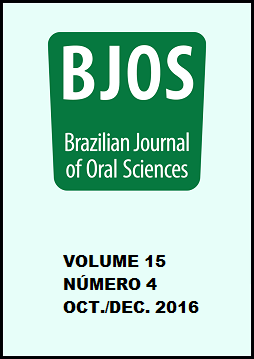Abstract
Self-adhesive, dual-polymerizing resin cements require no treatment to the prepared tooth surfaces before cementation. Aim: The aim of this study was to evaluate the influence of curing mode on bond strength (BS) of three cementing systems to bovine dentin. Methods: The buccal enamel surfaces of 50 bovine incisors were removed to expose dentin and to flat the surface. The teeth were divided into five groups (n=10), which consisted of two resin cements (Multilink and Clearfil SA Cement) that were tested in dual- (halogen light for 40 s) and self-cured modes, and a control (RelyX ARC). Two cylinders of resin cements (1.0 mm X 0.75 mm) were prepared on each bonded dentin surface. After 24h at 37oC, resin cylinders were subjected to micro-shear testing in a universal testing machine (4411/Instron - 0.5 mm/min). Data were statistically analyzed by two-way ANOVA, Tukey and Dunnett`s test (5%). Results: Multilink showed higher BS than those observed on Clearfil SA. Light-curing resulted in higher BS for both Multilink and Clearfil SA. When Multilink was light-cured, no significant difference on BS was demonstrated between it and RelyX ARC. Conclusions: The highest BS values were obtained in control group and light-cured Multilink resin cement.References
Belli R, Pelka M, Petschelt A, Lohbarrer V. In vitro wear gap formation of self-adhesive resin cements: a CLSM evaluation. J Dent. 2009 Dec;37(12):984-93. doi: 10.1016/j.jdent.2009.08.006.
Sekhri S, Mittal S, Garg S. Tensile bond strength of self adhesive resin cement after various surface treatment of enamel. J Clin Diagn Res. 2016 Jan;10(1):ZC01-4. doi: 10.7860/JCDR/2016/13409.7026.
Tiana T, Tsoib J K-H, Matinlinnab JP, Burrowa MF. Aspects of bonding between resin luting cements and glass ceramic materials. Dent Mater. 2014 Jul;30(7):e147-62. doi: 10.1016/j.dental.2014.01.017.
Irie M, Maruob Y, Nishigawab G, Suzukia K, Watts DC. Physical properties of dual-cured luting-agents correlated to early no interfacialgap incidence with composite inlay restorations. Dent Mater. 2010 Jun;26(6):608-15. doi: 10.1016/j.dental.2010.02.012.
Graiff L, Rasera L, Calabrese M, Vigolo P. Bonding effectiveness of two adhesive luting cements to glass fiber posts: pull-out evaluation of three different post surface conditioning methods. Int J Dent. 2014;2014:148571. doi: 10.1155/2014/148571.
Viotti RG, Kasaz A, Pena CE, Alexandre RS, Arrais CA, Reis AF. Microtensile bond strength of new self-adhesive luting agents and conventional multistep systems. J Prosthet Dent. 2009 Nov;102(5):30612. doi: 10.1016/S0022-3913(09)60180-3.
Shimada Y, Yamaguchi S, Tagami J. Micro-shear bond strength of dualcured resin cement to glass ceramics. Dent Mater. 2002 Jul;18(5):380-8.
Stefani A, Brito Jr RB, Kina S, Andrade OS, Ambrosano GMB, Carvalho AA, et al. Bond strength of resin cements to zirconia ceramic using adhesive primers. J Prosthodont. 2016 Jul;25(5):380-5. doi: 10.1111/ jopr.12334.
Noronha Filho JD, Brandão NL, Poskus LT, Guimarães JGA, Silva EM. A critical analysis of the degree of conversion of resin-based luting cements. J Appl Oral Sci. 2010 Sep-Oct;18(5):442-6.
Armstrong S, Geraldeli S, Maia R, Raposo LH, Soares CJ, Yamagawa J. Adhesion to tooth structure: a critical review of "micro" bond strength test methods. Dent Mater. 2010 Feb;26(2):e50-62. doi: 10.1016/j. dental.2009.11.155.
Braga RR, Meira JBC, Boaro LCC, Xavier TA. Adhesion to tooth structure: A critical review of “macro” test methods. Dent Mater. 2010 Feb;26(2):e38-49. doi: 10.1016/j.dental.2009.11.150.
Sano H, Shono T, Sonoda H, Takatsu T, Ciucchi B, Carvalho R, et al. Relationship between surface area for adhesion and tensile bond strength--evaluation of a micro-tensile bond test. Dent Mater. 1994 Jul;10(4):236-40.
Schenke F, Federlin M, Hiller K-A, Moder D, Schmalz G. Controlled, prospective, randomized, clinical evaluation of partial ceramic crowns inserted with RelyX Unicem with or without selective enamel etching. Results after 2 years. Clin Oral Investig. 2012 Apr;16(2):451-61. doi: 10.1007/s00784-011-0516-0.
Silami FDJ, Tonani R, Alandia-Román CC, Pires-de-Souza FCP. Influence of different types of resin luting agents on color stability of ceramic laminate veneers subjected to accelerated artificial aging. Braz Dent J. 2016 Jan-Feb;27(1):95-100. doi: 10.1590/01036440201600348.
Cantoro A, Goracci C, Carvalho CA, Coniglio I, Ferrari M. Bonding potential of self-adhesive luting agents used at different temperatures to lute composite onlays. J Dent. 2009 Jun;37(6):454-61. doi: 10.1016/j. jdent.2009.02.006.
Liu C, Liu H, Qian Y-T, Zhu S, Zhao S-Q. The influence of four dual-cure resin cements and surface treatment selection to bond strength of fiber post. Int J Oral Sci. 2014 Mar;6(1):56-60. doi: 10.1038/ijos.2013.83.
Ilie N, Simon A. Effect of curing mode on the micro-mechanical properties of dual-cured self-adhesive resin cements. Clin Oral Investig. 2012 Apr;16(2):505-12. doi: 10.1007/s00784-011-0527-x.
Arrais CA, Giannini M, Rueggeberg FA. Effect of sodium sulfinate salts on the polymerization characteristics of dual-cured resin cement systems exposed to attenuated light-activation. J Dent. 2009 Mar;37(3):219-27. doi: 10.1016/j.jdent.2008.11.016.
Kang E-S, Jeon Y-C, Jeong C-M, Huh J-B, Yun M-J, Kwon Y-H. Effect of solution temperature on the mechanical properties of dual-cure resin cements. J Adv Prosthodont. 2013 May;5(2):133-9. doi: 10.4047/ jap.2013.5.2.133.
Kim A-R, Jeon Y-C, Jeong C-M, Yun M-J, Choi JW, Kwon YH, et al. Effect of activation modes on the compressive strength, diametral tensile strength and microhardness of dual-cured self-adhesive resin cements. Dent Mater J. 2016;35(2):298-308. doi: 10.4012/dmj.2015056.
Manso AP, Silva NR, Bonfante EA, Pegoraro TA, Dias RA, Carvalho RM. Cements and adhesives for all-ceramic restorations. Dent Clin North Am. 2011 Apr;55(2):311-32, ix. doi: 10.1016/j.cden.2011.01.011.
De Munck J, Van Landuyt K, Peumans M, Poitevin A, Lambrechts P, Braem M, et al. A critical review of the durability of adhesion to tooth tissue: methods and results. J Dent Res. 2005 Feb;84(2):118-32.
Geerts S, Bolette A, Seidel L, Gueders A. An in vitro evaluation of leakage of two etch and rinse and two self-etch adhesives after thermocycling. Int J Dent. 2012;2012:852841. doi: 10.1155/2012/852841.
Reis AF, Giannini M, Kavaguchi A, Soares CJ, Line SR. Comparison of microtensile bond strength to enamel and dentin of human, bovine, and porcine teeth. J Adhes Dent. 2004 Summer;6(2):117-21.
The Brazilian Journal of Oral Sciences uses the Creative Commons license (CC), thus preserving the integrity of the articles in an open access environment.


